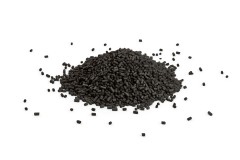
Activated carbon is produced from organic substances, such as coconut shells, turf, and various kinds of carbon, by means of heating and special treatment with a view to ensure a considerable increase in the inner and outer surface. The creation of very fine pores provide the adsorption of the effective surface up to 1250 m² per each gram of activated carbon. This extremely large adsorption surface has an outstanding level of separation and great capacity of storage – accumulation of harmful pollutants.
There are 2 different types of activated carbon (standard non-impregnated and impregnated carbon), that are commonly used for the removal of harmful pollutants from the air and for the cleaning of gases.
Standard non-impregnated activated carbon (AC) separates pollutants by means of physical adsorbtion. It is ideal for the adsorption of organic vapours and odours with a high molecular weight.
Table of the adsorption capacity for some substances in the application of standard non-impregnated activated carbon.
| Very good adsorption 20-30% of AC weight |
Good adsorption 10-18% of AC weight |
Very low adsorption 3-8% of AC weight |
| Toluene, xylene, petrol, phenols, benzene, chloroform, styrene, perchlorethylene, acetates, kerosene, turpentine, odours from kitchen, smokehouses, and meat processing plants, harmful pollutants generated by welding operations, odours from waste water treatment plants, body odours, harmful substances generated by gluing and soldering operations, solvents, tobacco smoke, hospital odours, disinfectants, and benzene | Ether, anaesthetic agents, acetone, methyl alcohol, phosgene, acetates, and smog gases | Acrolein, ethane, propane, ethylene, chlorine, methane, ammonia, formaldehyde, and carbon dioxide. Note: It is necessary to use special impregnated AC |
Special impregnated activated carbon separates harmful pollutants by means of chemical adsorption.
This kind of AC is used for the adsorption of gases and vapours that are adsorbed by standard activated carbon very little or are not adsorbed at all. This applies to low-molecular and polar substances with a low concentration and toxic effects.
When it is required to separate various harmful pollutants in one unit at the same time, it is necessary to design a filtration unit with AC impregnated at various levels.
Kinds of specially impregnated AC:
AC KR 1 ... for the removal of ammonia from gases and air
AC KC 10 ... for the removal of acid vapours and gases from air (partially SO2, HCI, SO3, and NOx
AC J 42 ... for the removal of sulfanes, hydrogen sulphine, and organic compounds of sulphur from air
AC HS 10 ... for the removal of formaldehyde from air
AC JQ 42 ... for the removal of mercury vapours from air and gases
AC CCA ... for the removal of phosphanes from air
AC RKJ 1 ... for the removal of of radioactive methyl iodide
AC ZS 10 ... for the removal of amines, alkaline vapours, and ammonia from air and gases
AC KR 4 ... for the removal of vapours of ammonia and organic substances of A and K groups
